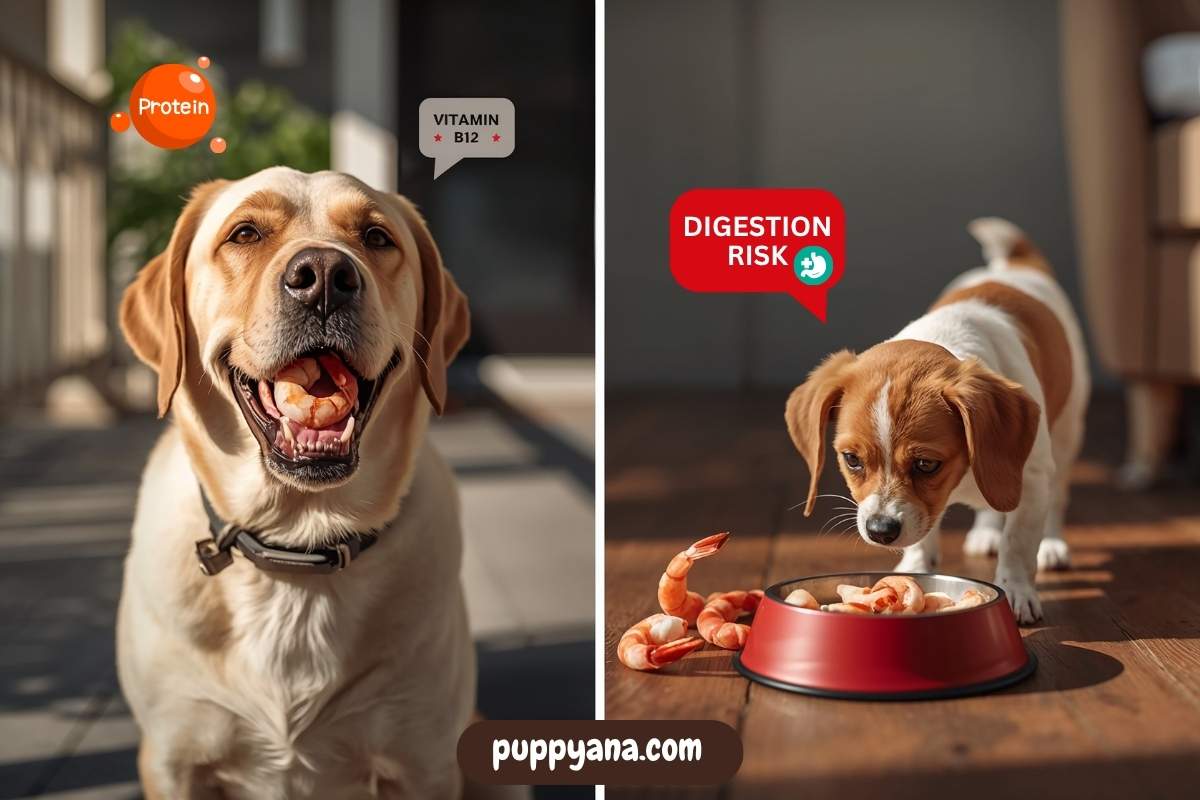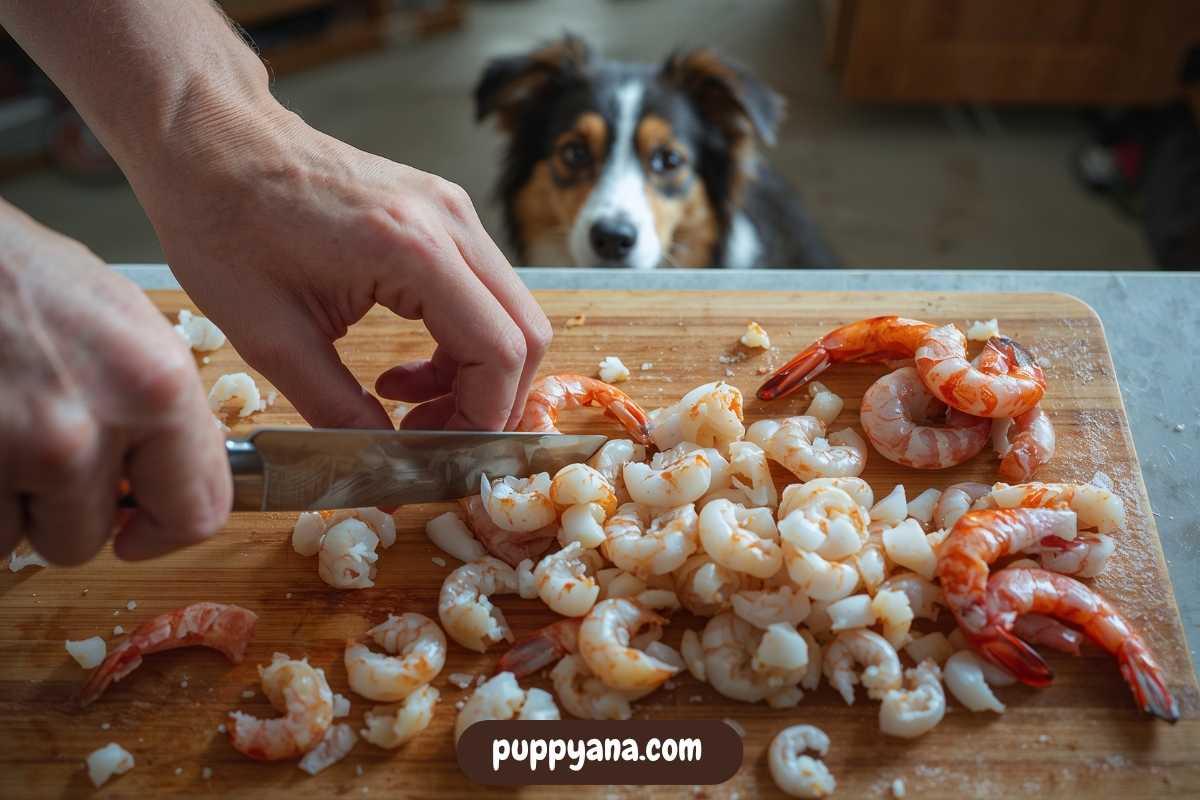Seafood can be a nutritious treat for us humans, but what about your dog? If you’ve ever cooked shrimp and noticed Fido giving you those hopeful eyes by the kitchen counter, you might be wondering, can dogs eat shrimp safely?
The answer isn’t a simple yes or no. While shrimp can offer some surprising health benefits to your dog, there are also clear rules around how it should be cooked, how much is safe, and when it can become a health risk.
In this guide, I’ll break down exactly what you need to know, including nutrition facts, preparation tips, vet-backed safety guidelines, and signs shrimp may not agree with your dog. Let’s dive in.

Table of Contents
ToggleIs Shrimp Safe for Dogs?
Yes, dogs can eat shrimp, but there are a few big caveats.
Shrimp is not toxic to dogs and can actually provide valuable nutrients like B12, protein, and antioxidants. However, it must be properly cooked, thoroughly cleaned (no shells, no tails), and served only in moderation.
According to the American Kennel Club (AKC), shrimp can be a lean, low-calorie snack that supports your dog’s overall health. But feeding the wrong kind, like raw, breaded, or heavily seasoned shrimp, can cause digestive trouble, sodium poisoning, or serious bacterial infections.
So the short answer is: shrimp is okay, if prepared properly and served wisely.
Can Dogs Eat Shrimp? Health Benefits and Risks
Shrimp is surprisingly nutrient-dense. When prepared the right way (steamed, boiled, or grilled with no seasoning), it offers benefits similar to other lean proteins, plus access to micronutrients most dogs don’t get in their everyday food.
| Nutrient | What It Does for Dogs |
|---|---|
| Vitamin B12 | Supports nervous system and brain function |
| Niacin (B3) | Aids energy use and fat metabolism |
| Phosphorus | Supports healthy bones and teeth |
| Antioxidants | Can protect cells from aging damage |
| Low in Fat and Calories | Ideal for dogs with weight concerns or on special diets |
Shrimp is also high in protein, which is essential for maintaining strong muscles and healthy skin. That being said, too much shrimp can throw off a dog’s overall nutrient balance if not carefully controlled.

Risks of Feeding Shrimp to Dogs
Just because something is healthy in theory doesn’t mean it works for every dog. There are several risks to consider with shrimp, especially if it’s poorly cooked or served too frequently.
Common Risks Include:
- Choking hazard – The tails, shell, or even whole shrimp can cause choking or injury in smaller breeds.
- Raw shrimp infections – Raw or undercooked seafood may carry harmful pathogens like Salmonella or Listeria, which can make dogs seriously ill.
- Too much cholesterol – Shrimp is high in cholesterol, which isn’t as concerning for dogs as humans, but still warrants moderation.
- High sodium in processed shrimp – Dogs are far more sensitive to excess salt, and many store-bought or frozen shrimp packs contain preservatives or brine that could be harmful.
- Food allergies – Shellfish is one of the more common animal food allergens for dogs. Reactions can range from itching to full-blown anaphylaxis.
As the experts at PetMD explain, even healthy treats like shrimp should never exceed 10% of your dog’s daily calorie intake, and should always be introduced slowly the first time.
How to Safely Prepare Shrimp for Dogs
Want to keep it safe? Follow this basic rule: plain, cooked, and clean. Never serve shrimp raw or with ingredients meant for human seasoning.
Safe Serving Prep Guidelines:
- Cook the shrimp thoroughly (boiled or steamed only — no oil, no frying)
- Remove shells, tails, veins, and legs — these are sharp and indigestible
- Chop it into small pieces for easy chewing and digestion
- Serve it plain — no butter, salt, garlic, onion, or sauce
The ASPCA warns that ingredients like onions and garlic are highly toxic to dogs, so never feed shrimp prepared in scampi, garlic butter, stir fry, or similar styles.

Can Dogs Eat Raw Shrimp?
No, dogs should never eat raw shrimp. Just like with humans, raw shrimp can carry dangerous bacteria and parasites that cause serious gastrointestinal illness in dogs.
Symptoms of bacterial infection may include:
- Vomiting
- Diarrhea
- Fever or lethargy
- Loss of appetite
Veterinary sources like VCA Animal Hospitals strongly advise against feeding any form of raw seafood to pets. Cooking shrimp kills off harmful microbes and makes the meat safer to digest.

Can Dogs Eat Fried or Breaded Shrimp?
Fried shrimp may be delicious to you, but it’s best to keep it off your dog’s plate.
Even small amounts of fried or breaded foods can potentially trigger issues like:
- Pancreatitis (due to high-fat content)
- Upset stomach or diarrhea
- Long-term weight gain
Breaded foods also often contain garlic, onions, or seasoning blends, which can be toxic. Remember: your dog’s digestive system isn’t built to handle rich or processed human foods.
If you want to offer shrimp as a treat, stick to steamed or grilled without seasoning.
How Much Shrimp Can Dogs Eat Safely?
Dogs should always eat shrimp in moderation, and portion size should be adjusted based on your dog’s size, breed, and regular diet.
Example Serving Chart:
| Dog Size | Max Shrimp Amount (Occasional Treat) |
|---|---|
| Small (under 20 lbs) | 1–2 small shrimp |
| Medium (20–50 lbs) | 2–3 shrimp |
| Large (50+ lbs) | 3–4 shrimp |
Make shrimp treats occasional, 1–2 times per week is enough. Shrimp should never be fed daily or as a meal replacement.
Can Puppies Eat Shrimp?
Yes, but only with extra caution.
Puppies have more sensitive stomachs and may be more prone to food allergies or digestive upset. If you decide to share shrimp with your puppy:
- Start with a tiny piece (pea-sized)
- Serve it thoroughly cooked and chopped
- Monitor closely for vomiting, loose stool, or signs of discomfort
The team at PuppyAna urges pet parents to steer puppies toward gentle proteins like boiled chicken or turkey first, as these are often easier to digest than shellfish.

Symptoms of a Bad Reaction to Shrimp
If your dog eats shrimp and doesn’t feel well afterward, keep an eye out for:
- Excessive gas or bloating
- Vomiting or diarrhea within a few hours
- Itching around the mouth or paws
- Redness in the ears or belly
- Trouble breathing (in severe allergy cases)
If your dog reacts poorly, avoid shrimp in the future and consult your veterinarian immediately, even small quantities can be dangerous for allergic pets.
The Humane Society emphasizes monitoring pets closely anytime new foods are introduced, especially seafood, which may lead to allergic responses in sensitive breeds. Here are some foods that can be poisonous to your dog.
Conclusion
So, can dogs eat shrimp safely? Yes, when it’s cooked, cleaned, and kept in moderation.
Shrimp is low in calories, rich in nutrients, and can be a tasty little protein boost for your pup. But it also comes with risks like allergies, contamination, or stomach upset if you don’t prepare it correctly.
If you want to offer shrimp, stick to:
- Fully cooked, plain preparation
- Shell-free, tail-free pieces
- Small portions a few times per week
As with any treat, shrimp should supplement, not replace, your dog’s balanced diet. And if your dog has tummy troubles or allergies, leave shrimp off the menu entirely.
Caring for your dog’s diet means knowing when to try something fun like shrimp and when to skip it. Do what’s best for your pup’s unique needs, and when in doubt, talk to your vet.
Frequently Asked Questions
1. Can dogs eat shrimp tails?
No. Shrimp tails are sharp and indigestible, creating a choking hazard and potential internal blockage.
2. What cooking method is best for shrimp for dogs?
Steaming or boiling without any seasoning is safest. Avoid frying, grilling with oil, or sautéing in sauces.
3. Can dogs be allergic to shrimp?
Yes. Shellfish is a common allergen for dogs. Reactions may include itching, vomiting, or swelling within hours of eating.
4. Is shrimp good for overweight dogs?
Yes, shrimp is naturally low in calories and fat, making it a good treat option, but portion control is still important.
5. Can dogs eat shrimp shells?
No. Shells can cause choking or damage to your dog’s digestive tract. Always remove shells before serving.
6. What should I do if my dog eats raw shrimp?
Monitor for symptoms like vomiting or diarrhea. Contact your vet promptly, especially if your dog is young, older, or has a sensitive stomach.
7. How often can dogs eat shrimp?
Once or twice a week in small quantities as a treat is plenty. Shrimp should not become a regular part of their daily diet.
8. Are store-bought frozen shrimp safe for dogs?
Only if they’re plain and unseasoned, and you cook them thoroughly. Avoid shrimp with additives, brine, or sauces.
9. Can shrimp cause gas in dogs?
Some dogs may experience gas or mild GI upset, especially when trying shrimp for the first time. Start slow to watch for reactions.
10. Can dogs eat shrimp tempura or scampi?
No. Anything fried, battered, buttered, or seasoned (like garlic shrimp) is unsafe for dogs and should always be avoided.





